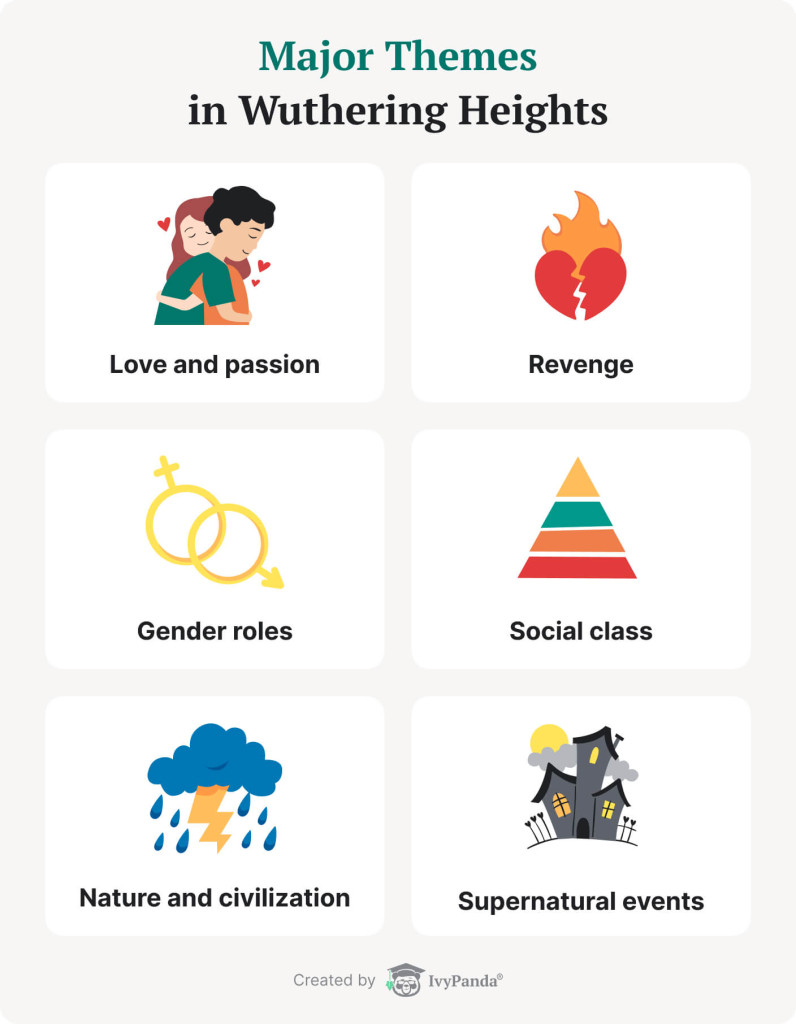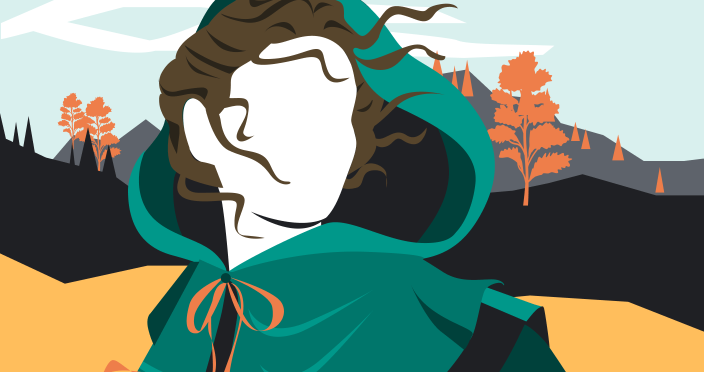The most significant Wuthering Heights themes include revenge, love and passion, gender roles, social class, the clash between nature and civilization, and supernatural events. As you can see, Emily Brontë’s novel tackles many pressing social problems that few 19th-century authors dared to address, along with timeless themes that remain relevant today.
But what is the theme of Wuthering Heights at its core? The truth is, there isn’t just one. The novel’s complexity allows for multiple interpretations, making it one of the most analyzed literary works.
To learn more about the themes of Wuthering Heights, read this article. Here, IvyPanda’s experts clarify the following:
- The way revenge fuels the story’s conflicts
- The role of love and passion in characters’ fates
- The impact of gender roles and social class on personal identity
- The clash between nature and civilization
- The importance of supernatural elements in the novel’s atmosphere
Ready to examine the themes in Wuthering Heights? Let’s start!
🗝️ Key Wuthering Heights Themes
Emily Bronte, also known under the pseudonym Ellis Bell, goes deep into the complexities of life in the Victorian era. Wuthering Heights shows the depth of human emotions. Among its significant themes are the difficulties of romantic relationships, the craving for revenge, the inequality between genders and social classes, and the coexistence of human beings and nature. Many of them remain relevant to this day. That is why the book is still a hot topic among readers. Below, we will analyze each theme separately with examples.

☠️ Theme of Betrayal in Wuthering Heights: Revenge Cycles
The theme of betrayal in Wuthering Heights is seen when Catherine marries Edgar Linton, thus betraying Heathcliff. As a result, since Heathcliff cannot have the woman he loves, he seeks vengeance.
The pursuit of revenge is one of the prominent themes of Wuthering Heights. The injustices the characters suffer, whether real or imaginary, plunge them into an endless cycle of vengeance. It often leads to the poor treatment of people who had no part in their predicament.
Here are the top examples of this theme in Emily Bronte’s work:
- Hindley Earnshaw punishes Heathcliff for appearing at Wuthering Heights by treating him like a servant and separating him from Catherine.
- Heathcliff uses his hatred to manipulate Hindley out of ownership of the estate.
- Heathcliff becomes the guardian of Hareton, Hindley’s son. Heathcliff treats the boy with the same cruelty he himself experienced as a child.
- Cathy Linton was kept prisoner by Heathcliff as revenge against Edgar Linton.
- Heathcliff takes vengeance on the Lintons through his treatment of Isabella Linton.
Revenge vs Forgiveness
Despite retribution driving much of the novel’s plot, it’s also a tale of forgiveness. Cathy and Hareton display this trait several times in the book. Cathy forgives Linton for his personality and Heathcliff for his actions, even though he treated her poorly at the hill house. Also, Hareton excuses Cathy and Heathcliff for making fun of him.
🌿 Nature and Civilization Themes in Wuthering Heights
Emily Bronte uses nature as an inspiration and, at the same time, recognizes its power and splendor. This way, she’s able to distinguish between civilization and nature.
Here are several examples that show this theme the best:
- In Bronte’s novel, most characters are associated either with civility or wilderness.
- Heathcliff and Edgar are opposites. The first represents nature and untamed elements, and the second represents civility and social norms.
- Hareton and Linton are also different. Heathcliff’s son is weaker and more polite, while Hindley’s offspring is more brutal and rugged.
- The roughest characters in the book are in tune with the natural forces, while their higher-class counterparts are less in touch with the world around them.
- Despite this surface dichotomy, many Wuthering Heights characters, such as Catherine Earnshaw or Hareton, show elements of both civilization and nature.
Isolation Issues
One aspect of the nature theme in the novel is the issue of isolation. The book is set in a remote location on the Yorkshire moors, away from civilization. So, the characters tend to live in seclusion. Therefore, there is a gap between them and their social status. Catherine, Frances, and Isabella all die alone and isolated. Even Heathcliff’s death happens behind closed doors.
💔 Theme of Love in Wuthering Heights
Emily Bronte’s book depicts different types of love. Some are universal and mundane, while others are all-consuming and blood-chilling.
Here are the best examples of this theme:
- Heathcliff’s love for Catherine Earnshaw is obsessive and possessive.
- Edgar Linton’s feelings for Catherine are more contained and civilized.
- Catherine Earnshaw falls for Heathcliff and Edgar for different reasons but is undeniably in love with both men.
- Cathy Linton and Hareton’s love is balanced. It has neither obsession nor excessive passion.
- Hindley Earnshaw’s relationship with Frances is also more civilized, but the man later becomes consumed by his grief.
Ironic Representation of Love
The Wuthering Heights novel is full of ironic and twisted relationships. By showing affection towards Heathcliff, Mr. Earnshaw sets him up for a life of abuse from Hindley. Catherine loves Heathcliff but marries Edgar. Heathcliff, despite his feelings for Catherine, marries Isabella Linton. His marriage becomes another route to revenge despite the other’s feelings. Ironically, no one found happiness in these relationships.
♀️ Theme of Gender Roles in Wuthering Heights
The novel was written during a time of strict gender roles. Writers often describe stereotypical characters that possess clichéd gender traits. However, Emily Bronte decided to go against the adopted rules of 19th-century British literature:
- Edgar and Linton show the softer side of masculinity.
- Catherine Earnshaw combines female beauty and masculine strength.
- Heathcliff is the epitome of the exaggerated negative and positive sides of masculinity.
- Hareton demonstrates more restrained masculine qualities, but at the same time, his temperament can hardly be called soft.
The Theme of Power in Wuthering Heights: Patriarchy
Emily Bronte’s work reflects the society she lived in. Most poignantly, it critiques the patriarchal society of the Victorian era, which treated women as second-class citizens. The men of this story subjugate them for personal needs. This is most apparent when Heathcliff forces Cathy Linton to marry his son. Another good example would be when Edgar Linton manipulates Catherine Earnshaw and asks her to choose between him and Heathcliff.
👻 Themes of Wuthering Heights: Ghosts & Supernatural Events
While the supernatural elements stay mainly in the narrative’s background, their thread is woven throughout the story. Let’s look at the several times they appear in this gothic novel.
- Mr. Lockwood sees the ghost of young Catherine Earnshaw and is terrified by this experience.
- Heathcliff asks the ghost of Catherine Earnshaw to haunt him until he dies.
- Another example of supernaturalism is in the words of a shepherd boy, who claims to have seen the ghosts on the moors after Heathcliff’s death.
- Heathcliff digs up Catherine’s grave and removes a part of her coffin so the two can be together in the afterlife.
🕯️ Theme of Social Class in Wuthering Heights
Do you want to understand the meaning of Wuthering Heights? Then, you should first get familiar with the history of the United Kingdom between the XVIII and XIX centuries. It was a time when one’s class dictated their future.
Here are the main problems the characters faced due to their social class:
- Heathcliff’s lower-class origin makes him a subject of ridicule from Lintons and Hindley Earnshaw.
- Catherine chooses Edgar Linton over Heathcliff because of his social status.
- Cathy and Catherine can’t inherit any property as these rights were reserved for men.
- Despite his wealth, Heathcliff still isn’t considered a higher-class person due to his lineage.
- Cathy Linton can’t inherit Thrushcross Grange after her father’s death.
We hope you found all the answers you were looking for. If you have trouble understanding the literary devices Emily Bronte used in her novel, check out our article on figurative language use in Wuthering Heights.
